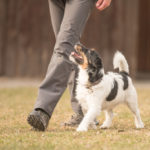One of the first things you need to know about before having a dog is the importance of training. Training should start as soon as possible, as it makes such a difference in how your dog behaves.
If your dog is able to follow commands, you will have a much happier relationship with your dog, and both of you will be much safer. Commands are essential in keeping your dog in line, and ensuring that they are behaving in a safe and acceptable manner.
This will be so that you can live happily and peacefully with your dog for many years to come. So, why should you train your dog, and what are the most essential commands every dog should know?
Let’s take a look.

Why You Should Train Your Dog
There are many good reasons why you need to train your dog. For instance, training your dog will create a much stronger human-animal bond, and will establish a relationship of trust and respect between you and your pooch.
Training can also help to bring confidence and independence to your dog, whilst also keeping them safe from harm.
For instance, if you do not train your dog to behave, they could run up to other dogs, wanting to jump all over them and play with them, but the other day may become aggressive and could snap at yours.
This is why you will need to train your dog to obey your commands, come when you call, and stay put when you tell them to.
Not only does training prevent your dog from danger, but it is also essential to your dog’s wellbeing. Dogs have so much energy, and are so eager to please.
Some breeds such as working breeds are also incredibly intelligent, and will need a lot of exercise or mental and physical stimulation to keep them happy and occupied.
Training, along with a routine can keep your dog healthy and happy in this way, as it will provide your dog with physical exercise, whilst also keeping their minds active and engaged.
Training your dog can for the most part ensure that both you and your dog are happy.
It can banish unwanted behaviors, and reinforce good behaviors so that you have the perfect canine companion as part of your family. Training a dog is therefore essential to your happiness, and your dog’s quality of life.
What Is The Best Method To Train Your Dog?
Ask any dog lover, enthusiast or handler, and you will find that positive reinforcement is the key to training a dog. Dogs are very food motivated, and will literally do anything for treats and kibbles.
However, positive reinforcement is not just about the treats you give as a reward, it’s also about how you react to your dog.
If you react in a positive manner, praising them and being loving towards them, they will recognize that behaving in a certain way or following a certain command results in lots of love and praise from you.
Training your dog should also be fun for the both of you, and if your dog is bored, it is probably time to finish training for the day, so you’ll need to keep the training sessions short, but consistent.
You should also train your dog with only positive rewards, and never punish your dog for not doing what you want. This will only weaken your bond, as the dog will become fearful of you and will behave in an anxious or even aggressive manner.
Positivity is the key!
Keep the training sessions in a quiet area, as your dog may become too distracted to respond to your commands well, and don’t forget to be patient, your dog will get there with consistency and positivity.
What Are The First Commands I Should Teach My Dog?
The most basic skills that your dog should learn are to sit, stay, and come. These will ensure that you can call your dog, so that they have good recall skills, and so that they are obedient.
If your dog cannot sit, or stay, they could run into dangerous situations, or run into the street when you open the front door.
The best commands to start with are Sit, as this is the easiest to teach, followed by Stay and Come, so that your dog knows when to listen and run to you.
20 Essential Commands To Teach Your Dog
Sit
Sit should be taught first, as this is the position they need to be in to have a reward. To teach Sit, hold a treat above the dog’s head, move it behind the head until they crouch and sit for it. Then say Sit and give the treat.
Stay
Make your dog sit, and slowly back away whilst saying Stay. If they move forward, say No, and wait for them to stay and wait for your command. Reward with a treat.
Down
To do this one, hold a smelly treat in front of your dog to entice them.
Then ,wait for them to smell it, and start to bring the treat down to the floor, with the dog following. When their stomach touches the floor, say Down and give the treat.
Watch Me
Your dog needs to pay attention to you, teach Watch Me by holding a treat near the dog’s nose, and slowly bring it to your face, and say Watch Me when their eyes are on you.
Reward with the treat.
Wait
With your dog in its crate, start to open the door. If the dog moves towards you, shut the door. Tell them to wait, and reward with a treat when they no longer go straight for the door when it opens.
Come
With your dog on a leash, stand away from them and say Come, whilst tugging on the leash. When they come, reward.
Off
If your dog tries to get onto furniture, hold a treat in your hand, and say Off until they back down and sit on the floor. Give the treat when they avoid climbing on furniture and people.
Drop
Have two toys at the ready. Give one to the dog, and say drop it, whilst showing them the other toy. When they drop the first toy, reward them.
Leave It
Hold a treat or toy in front of your dog, but keep a treat hidden in another hand held behind your back. They’ll try to grab the first treat, but say Leave It. When they demonstrate this, reward them with the hidden treat.
Heel
Walk with your dog leashed, and hold it tight. Every now and again, tell your dog to sit, and treat them when they do, then keep walking.
Keep your dog tight on the leash, and keep treats handy. When you say Heel, and they respond, treat them. This one will take a few walks every day until you crack it.
No
Place a treat/toy on the ground, walk with your dog on a leash towards the treat, and say No whilst lightly pulling on the leash. When they leave it, give a treat from your hand or treat bag.
Bed
Point to the bed, and say Bed, placing a treat on the bed, and watch them go into the bed and stay there.
Speak
When it looks like your dog is going to bark, say Speak loudly before they do, and reward them.
Quiet
The same goes for this one. When your dog is barking, say Quiet loudly, and reward them when they stop.
Shake/Paw
Have your dog sit, and hold a treat in your fist. Place it in front of their paws and say Shake or Paw, and when they paw at it, shake their paw and give the treat.
Car
Just like Bed, point at the Car, say the phrase, and wait for them to jump in, then reward them.
Belly
Once your dog has cracked Down, you can try Belly.
Have them in the down position, and hold a treat in hand, moving it to the side of their head so that your dog rolls onto its side. Then, when they are on their back, say Belly, and give the treat.
Take
Hold out your dog’s toy and have a treat handy. Say Take it, and when they do, give them the treat for taking the toy from you.
Lap
Similar to bed, sit on a chair and hold a treat on your lap. Pat your lap to encourage the dog, and say Lap, and reward them when they put their paws up or jump up onto you.
Poop/Pee
When it looks like your dog needs to go, open the door to outside, and repeat the phrases that you choose for them to do their business to encourage them.
Once they’re done, let them back in and give them a treat. As you can see, there are many commands to teach your dog, but all have one thing in common…they’ll do anything if there’s treats involved!
- 8 Signs That Your Dog Is In Heat - November 8, 2022
- Why Is My Dog Whining Whilst Carrying A Toy In Their Mouth? - August 17, 2022
- Reasons Why Your Dog’s Poop Is White And What To Do About It - August 17, 2022









